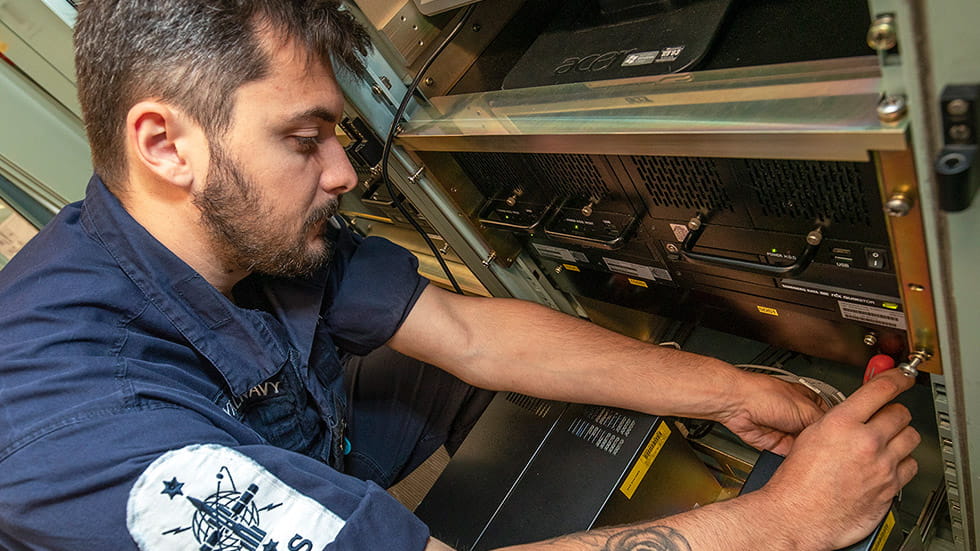Accelerated Apprentice Scheme (Communications Information Systems)
You’ll be fast-tracked to working with one of our most elite teams, transmitting and receiving crucial messages.
- £37,500 - £54,500
- GCSEs
- Surface Fleet
- Engineering
- Rating level
£37,700
£54,500
World travel
Free
Extra pay
6 weeks

I’ve travelled all over the world, doing what I love. My role is vital to keeping the ship communicating with our colleagues ashore and afloat, whilst also making sure that my shipmates can keep in touch with their families back home.
Role details
What you’ll do
Joining on the Accelerated Apprentice Scheme (Communications Information Systems) means you won’t wait long to be in the thick of the action. When qualified as a Leading Engineering Technician Communications and Information Systems (CIS) Specialist, you’ll be managing your team of network engineers from the heart of every mission.
Every day, you’ll be solving complex issues to enable the secure exchange of mission critical and often top-secret information. It will also be your responsibility to deliver and administer specialist communications and IT equipment, including classified information and cryptographic material.
Your role
- Operate sophisticated global networked information systems, so you're always able to receive communications that are crucial to the day-to-day operation of the ship
- Manage your team to take responsibility for the ship’s complex data-processing network systems, utilising the latest satellite technology to deliver everything from complex warfighting communications to the welfare internet, placing you at the heart of tactical and strategic communications
- Manage the day to day delivery of communications between Royal Navy Ships, their aircraft including F35, and International Task Groups to keep the Battlespace informed
- Find a solution to whatever problem comes your way, working with your team in challenging environments and high-pressure situations
Pay & benefits
- A starting salary of over £37,000, rising to in excess of £54,500 as your career progresses
- An excellent non-contributory pension scheme – we pay into it for you, so you don’t have to sacrifice any salary
- Six weeks of paid holiday every year
- Free medical and dental care
- Additional pay for each day spent at sea
- Amazing opportunities, including world travel and adventurous training for two weeks every year
- Free gym and sports, from football to kayaking to kite-surfing
- Subsidised travel, accommodation and food
Skills for life
Qualifications you'll gain
- Professional qualifications including a Level 4 Apprenticeship in IT
The opportunity to gain
- Work towards a degree like Information Systems or Computing
Skills you'll develop
- Learn to operate and administer sophisticated communications equipment, including global radio and satellite systems
- Develop practical skills and your natural aptitude for fixing things to find a solution if a problem arises
- Working within one of the key hubs within a ship, become the ultimate team player, working with your colleagues in the Engineering branch to keep the ship operational, and collaborating with your crewmates on other projects
Eligibility
- You need to be aged between 17 to 25
- A minimum of three GCSEs (or equivalent) at grade 4 or above including English Language, Mathematics and at least one science
- You must be a United Kingdom citizen or British Dual National. Dual Nationality restrictions do apply
- You must have lived in the UK for 5 years continuously prior to application
- A Body Mass Index (BMI) between 18 and 28 (between 17 and 27 if under 18)
There are two options for acceptable qualifications required in addition to the basic academic criteria above:
Option 1
A vocational qualification in an Engineering/Computing discipline at Level 3, generally carrying the title ‘Level 3 Diploma/Extended Diploma in Engineering’
Option 2
At least 48 UCAS points in A-Levels (or equivalent) in Mathematics and STEM subject (minimum grade D or above in each subject)
Skills & interests
- A quick thinker, with a passion for working with the latest equipment and technology
- A problem-solver who can work well as part of a team
- A real sense of adventure, with a high level of physical and mental fitness
- Enthusiasm for fixing and maintaining electronic and mechanical system
Joining process
From picking your role to starting on your first day, these are the steps you'll take to join as a rating.
Submit an application
Defence Aptitude Assessment (DAA)
You’ll be tested on: Verbal Reasoning, Numerical Reasoning, Work Rate, Spatial Reasoning, Electrical Comprehension and Mechanical Comprehension.
To prepare, you can practise the DAA
Interview
Medical and eye tests
Pre-Joining Fitness Test (PJFT)
Candidate Preparation Course (CPC)
Start training
Career Progression
Got a question?
Our virtual recruiter is available to answer your questions 24 hours a day
